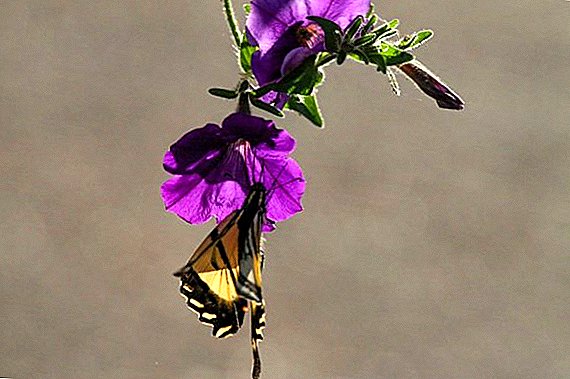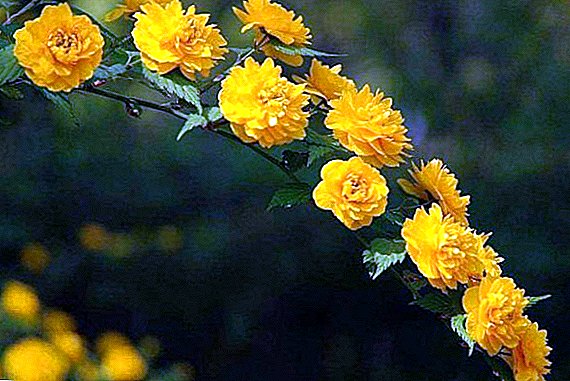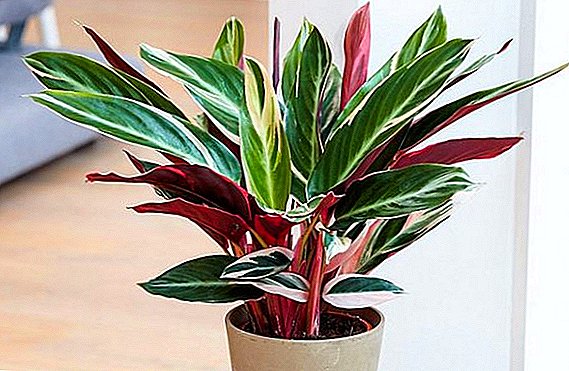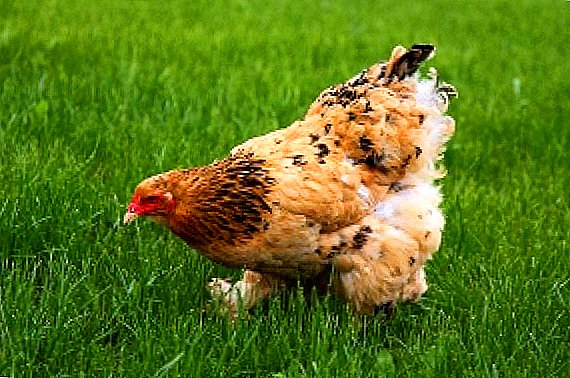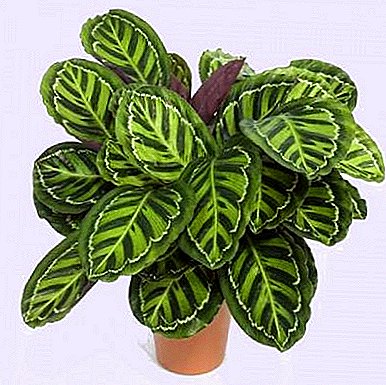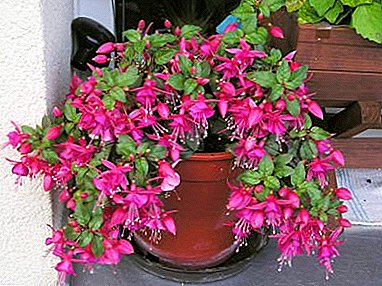
Fuchsia is an evergreen shrub, which bloom had to taste many lovers to grow flowers at home.
Like any other plant, the flower requires certain conditions for growing. Observing the rules of care, you can make a fuchsia a real decoration of any apartment or house.
From the article you will learn how to care for a flower, what fertilizers to choose. Read the step-by-step instructions for growing plants from seed, reproduction and transplantation.
Basic rules of care
The plant is relatively unpretentious, but you need to care for fuchsia carefully, remembering all the rules and restrictions.
Pot selection
The pot is desirable to choose a ceramic. In a plastic pot, the plant will be hot in summer, and it is better to take care of it in advance, protecting the roots from excessive heat.
The size of the pot should be directly dependent on the size of the root. It is better to transplant a plant several times than to plant a fuchsia in a huge pot. This is due to the fact that the soil, not developed by the roots, can begin to turn sour, which often causes rotting of the roots.
The presence of drainage holes is one of the main criteria for choosing a pot. Fuchsias do not tolerate stagnant water.
Some lovers of this flower use pieces of charcoal as drainage.
Required soil composition
 Powering fuchsia requires light soils with good drainage and neutrality.. It is best to independently mix the soil in the right proportions, thereby protecting the plant from harmful elements that can get into the universal soil.
Powering fuchsia requires light soils with good drainage and neutrality.. It is best to independently mix the soil in the right proportions, thereby protecting the plant from harmful elements that can get into the universal soil.
- The best option is peat, compost and leaf humus mixed in the same volume with the addition of double the volume of sand.
- You can also mix turf, leaf humus and ash in a ratio of 5: 2: 2. In this embodiment, the humus can be replaced with granulated peat.
Both of these options are suitable as a home soil mix and serve as a nourishing and moisturizing primer for growing fuchsia.
How to correctly form the humidity level?
The plant needs to form and maintain a moisture level that is around 60-70%. The exception is the period of rest, which comes in winter. For spraying, it is advisable to use a bottle with separated water and a spray bottle. There are several rules for proper hydration:
- water should be warm;
- spray should be twice a day;
- if several fuchsias grow in a flower garden, it is not necessary to use a spray gun - it is better to take a small bowl, fill it with pebbles and fill it with water.
Lighting
It is necessary to provide the plant with good lighting, putting it near the windows not on the sunny side, for example, on the balcony, whose windows face west or east.
In dark rooms, fuchsia blooms may deteriorate.however, green mass develops quite well. Therefore, in order for the flower to grow well, on sunny days it is better to expose it to the light, but at midday to tidy up the place darker. It is permissible to use window blinds or other thick curtains that will provide a good shade.
Temperature conditions
 Before you grow a plant, you need to remember that fuchsia roots like a cool temperature, so it is better that the flower is not in a room whose air temperature is 30 ° C, as this can lead to death.
Before you grow a plant, you need to remember that fuchsia roots like a cool temperature, so it is better that the flower is not in a room whose air temperature is 30 ° C, as this can lead to death.
- In summer, the temperature should be between +18 and +24 ° C.
For cooling, it is better to use protection from sunlight and a good stream of fresh air. This is another reason why a balcony can be a place to “live” a flower.
- Winter temperature should not exceed + 5 ... + 12 ° С.
Watering
The need for watering will indicate a dry earthen room.
- In summer, the flower should be watered at least 2 times a week, in autumn and spring - once every 1-2 weeks.
- In winter, the frequency of irrigation should be reduced to 1 time per month (for details on how to properly prepare fuchsia for wintering and how to keep it in the basement and in the cellar, read here).
Water the flower to be separated with water.whose temperature is not higher and not lower than room temperature.
Fertilizers
Proper selection of elements in the dressing will protect the flower from disease, contribute to good growth and improved flowering.
It is necessary to choose a top dressing, relying on the growth phase of the plant.
- Young specimens need fertilizer containing a large amount of nitrogen - this element will ensure the growth of shoots.
- The grown fuchsia loves fertilizers containing phosphorus and potassium.
The frequency of fertilizer should depend on the concentration of feeding. Normal concentration is usually used with fertilizer once in 7-10 days, but if fertilizing is carried out with each irrigation, the solution should be made weaker, at least 3-4 times. Mineral fertilizer is better to alternate with organic.
Items that will be useful for fuchsia:
- nitrogen;
- phosphorus;
- potassium;
- manganese;
- iron;
- zinc;
- magnesium.
Watch the fuchsia care video:
How to grow a flower: step by step instructions
- It is necessary to choose a pot, soil and fertilizers. To get started, stop on a small pot made of ceramic, about 10x10 in size.
- Pick up the soil - you can buy a universal mix, adding a little sand to it, or mix your own turf, peat and sand in a ratio of 3: 2: 1.
- The first fertilizer also needs to be entered simple - the soil with the addition of nitrogen is perfect for starting flower care.
Read more about the rules of growing room and garden fuchsia here.
Seed preparation and germination
 Fuchsia seeds can be purchased at any gardening shop. Sow seeds best in February.
Fuchsia seeds can be purchased at any gardening shop. Sow seeds best in February.
Before sowing, the soil must be moistened with a solution of potassium permanganate from a spray bottle.
Seeds when planting do not need to bury deep in the ground - just enough to slightly press the seed: the plant needs light for good germination.
Next you need:
- cover the pot with transparent cellophane or film;
- put on the window sill;
- monitor temperature and moisture.
If all actions are performed correctly, already in 3-4 weeks you can expect the appearance of the first small shoots. During this period, it is very important to lift the cellophane, removing the concentrate. After germination, cellophane is recommended to be removed for a longer time to adapt the plant to room conditions.
Care
When the soil dries, it should be moistened with a spray gun, sprinkling the earth around the sprout. Water for irrigation should be separated at room temperature.
The ambient temperature for proper growth should be around 18-22 ° C.
Constant lighting should provide good sprout light, while protecting them from direct sunlight. Best of all - put the pot on the window sill.
Sprouted sprouts after the appearance of the first leaves should be periodically sprayed a small amount of water, you can the same that is used for watering. Spraying 1-2 times a week will provide the necessary level of humidity.
Reproduction and transplanting
If you intend to propagate the plant with seeds, you should first protect the unblown bud from self-pollination and pollination by insects.
- Dust buds need to be removed in advance, and the bud close with a cover of paper or cloth.
- When the flower is ripe, the seeds must be carefully collected and sown in accordance with the procedure described in the previous paragraph.
 Vegetative breeding method can be used in any period of the year, but experienced breeders recommend practicing them in the spring. Observe the following rules:
Vegetative breeding method can be used in any period of the year, but experienced breeders recommend practicing them in the spring. Observe the following rules:
- for breeding you need to choose a young stalk length from 10 to 20 cm;
- remove the leaves at the bottom of the cutting, the rest - cut in half;
- put the cutting into filtered water;
- cover the top with a wrap or bag, you can use the bottle.
You can wait for the first roots in 4-5 daysHowever, in some cases you have to wait about 2 weeks. When they appear, you need to immediately plant a stalk in the substrate.
Details on how to propagate fuchsia from a leaf, read in here, and from this article you will learn how to correctly transplant fuchsia and get a rich flowering.
Watch the video about breeding fuchsia cuttings:
Diseases
Problems with fuchsia can occur due to non-compliance with home care rules, or due to pest damage. Consider the most common diseases.
- Root rot. Appears due to a large amount of moisture. To get rid of the problem, you need to get the plant out of the pot, wash the roots with warm water, cut off the rotten roots, put the plant in a container with clean water. When new, young roots appear, it is allowed to plant a flower in a new soil again.
- Gray rot. It affects the leaves because of the high humidity in the room. In this case, the damaged sheets need to be cut, and the room is regularly aired.
- Growth retardation. Most often due to lack of space in the pot, so you should transplant fuchsia.
- Lack of trace elements. If the leaves wither and brighten - there is not enough nitrogen, when they turn yellow - manganese, they dry up, acquiring a brown tint - molybdenum.
- Whitefly defeat. This insect lays eggs on the back of the leaves. As a result, white droplets can be seen on the sheets, after which the leaves turn yellow and fall off.To fight it is necessary to wash the flower with soapy water, paying particular attention to the inside of the leaf and the stem, but protecting the roots from water.
- Defeat red spider mite. The main signs are gray bloom and black dots on the sheets. To combat the use of special anti-insect.
Compliance with the basic rules of care and the timely detection of diseases will allow a large flower to grow, which will delight all residents with its flowering and will become a real decoration in both the room and the garden. Given all the features, you can call fuchsia a picky plant, but this does not mean that it does not need proper care.


